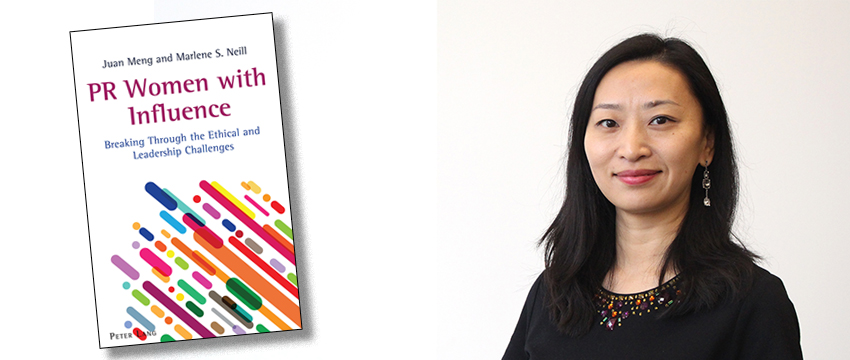Trends and challenges revealed in new book about women and leadership in public relations

Trends and challenges revealed in new book about women and leadership in public relations
Advancement barriers, gaps in leadership and lack of mentors examined
A new book, PR Women with Influence: Breaking Through the Ethical and Leadership Challenges, explores how women in the profession of public relations and communication navigate through attitudinal, structural and social barriers in advancing their leadership roles. The book is led by Juan Meng, associate professor at the University of Georgia Grady College of Journalism and Mass Communication and co-authored by Marlene S. Neill, associate professor at Baylor University.
Grounded by empirical research, the book illustrates the ethical and leadership challenges women in PR face. Some key highlights include:
- Situational barriers to women’s leadership advancement in public relations;
- The meaning of building influence to women in public relations;
- The strategies to set out principles that uphold the core values of ethical leadership;
- Women’s leadership development and participation opportunities in public relations; and
- The crucial supporting roles of mentoring and sponsorship in leadership advancement.
The book was published by Peter Lang International Academic Publishers and is part of the AEJMC-Peter Lang Scholarsourcing Series. The book is developed from a research project co-sponsored by The Arthur W. Page Center for Integrity in Public Communication and The Plank Center for Leadership in Public Relations.
The results are based on responses from two phases of research. Phase I involves 51 in-depth interviews with current female executives in public relations and communication and Phase II reflects information and opinions recruited from a national panel of 512 female public relations and communication professionals.
“Our goal with this book is to examine the joint topics of ethics counseling and leadership challenges that woman in public relations and communication are facing,” Meng said. “We hope to enrich the body of knowledge in women and leadership in public relations while advancing our understanding of identity- and gender-based leadership development skills and ethics counseling strategies.”
Barriers in leadership advancement
Women in PR agree that there is a substantial percentage of women (61.9%) serving as direct supervisors at junior and/or middle management levels to fill in the leadership pipeline. However, the pattern of men outnumbering women in senior communication leadership is persistent by ethnicity, as well as across different types of organizations.
As rated by women in PR, the top three situational barriers that influence women’s leadership advancement are:
- Double standards in domestic roles and professional demands (58.6%),
- Social attitudes toward female professionals (57.4%), and
- Workplace structures (57.2%).
Women of color are specifically disadvantaged by race-based stereotypes.
Women in the study highlighted the top three factors contributing to the underrepresentation in top leadership:
- Lack of women as role models in high-level decision-making positions (43.4%);
- Lack of work-family balance (36.9%); and
- Lack of power of authority or control over important resources (35.2%).
Multiple meanings of being a female leader in public relations
The majority of surveyed professionals in the study define influence as the following ways:
- Being valued as a trusted advisor (85.7%),
- Having career advancement opportunities (84.0%),
- Demonstrating expertise (83.0%), and
- Having a voice that colleagues and co-workers listen to (82.8%).
Women of color define influence with strong opinions by highlighting the importance of gaining visibility through senior leadership positions.
At the same time, women in PR use multiple strategies to build and enact their influence when providing leadership and ethical counseling. Those widely used strategies include the following:
- Inviting questions and building a dialogue (74.0%),
- Referring to the core values of the organization (70.1%),
- Providing scenarios, discussing potential consequences and providing alternative solutions (69.5%).
Efforts are needed to minimize the gap between leadership development and participation opportunities for women in PR
It is promising that nearly 64% of female professionals agree that their organization has on-the-job training programs to increase competency. Respondents also reported having access to internal and external leadership training and development programs. However, insufficient leadership development resources are particularly noticeable for women in the 31- to 40-year-old bracket.
The gap between leadership development and participation is noticeable. Female professionals reflect that as the line responsibility and the decision-making power increase, their opportunities to participate in leadership initiatives decrease. Four out of ten women don’t think they’ve been given sufficient leadership participative opportunities in organizations’ important initiatives. Quite surprisingly, a substantial percentage of women (41.5%) disagree their organization helps “women like me” participate in one or more professional associations to build networks.
Mentors are important but the numbers are insufficient
Women in PR agree that mentorship does not only provide career advice but also contributes to network building. However, results show that three out of ten female professionals admit they do not have any mentors. In addition, more Black women reported not having a mentor (35.0%), compared with white women (28.6%) and other minority women (28.8%).
“By talking to those successful women executives in PR who were willing to share their personal experiences and provide guidance,” Neill said, “we found one of the most insightful pieces of advice was regarding the role of advocates in career advancement. Senior leaders need to be more willing to identify, mentor and champion young professionals and offer them personal growth opportunities.”
Several factors are sought after when identifying mentors for women in PR including:
- On-the-job communications and experiences (29.7%),
- Personal connections and networks (24.2%), and
- Professional associations (17.8%).
“The depths and the insights from the book can be used to build a roadmap for younger generations and women of color who aspire to move into leadership,” Meng concluded. “Today’s public relations industry is facing enormous pressure to address gender and racial diversity at all levels. We hope our book contributes to addressing disparity, stimulating change, and leveraging the profession to be more diverse, equal and inclusive.”
For more information about this book, please visit https://www.peterlang.com/view/title/70618.